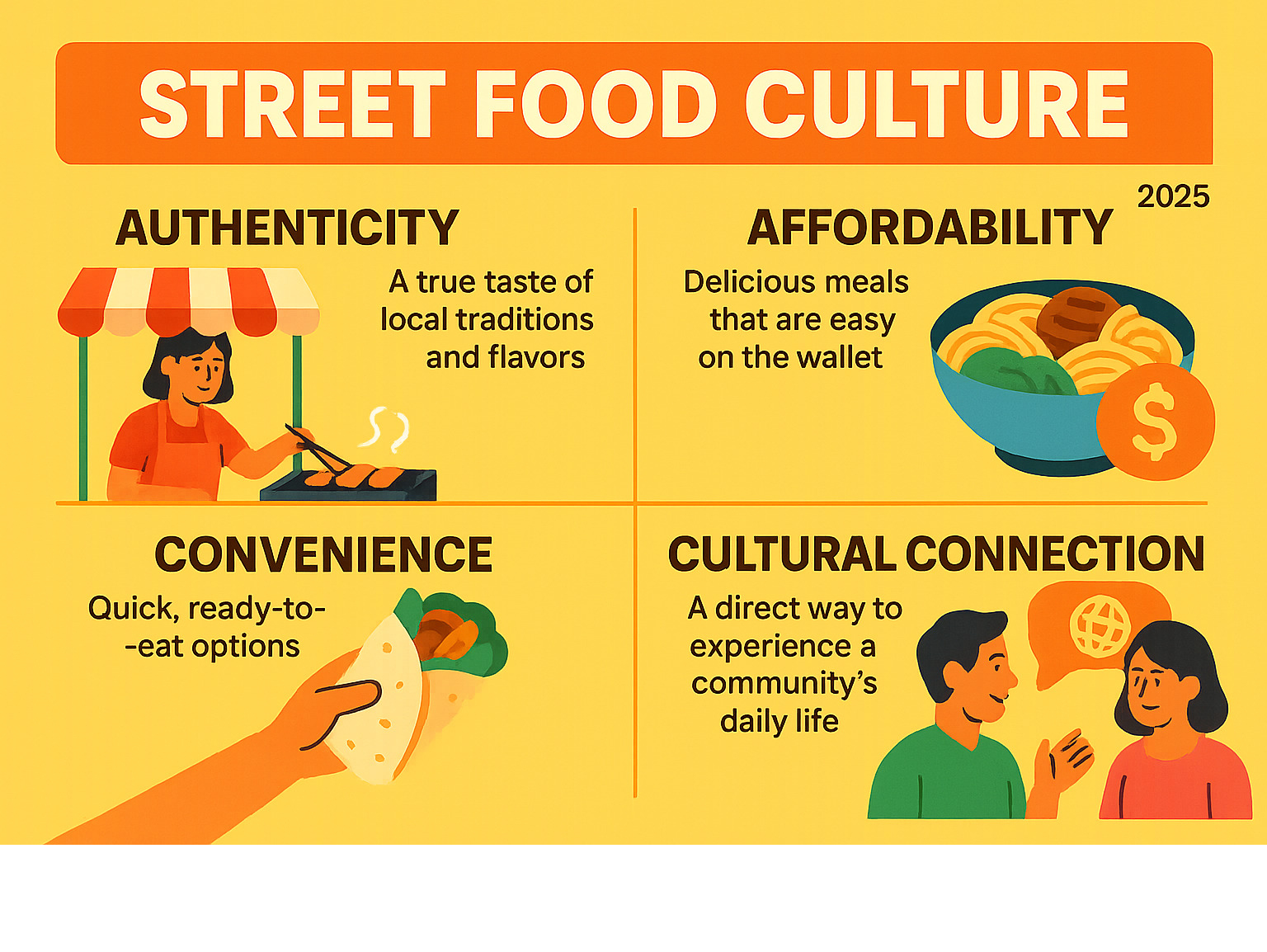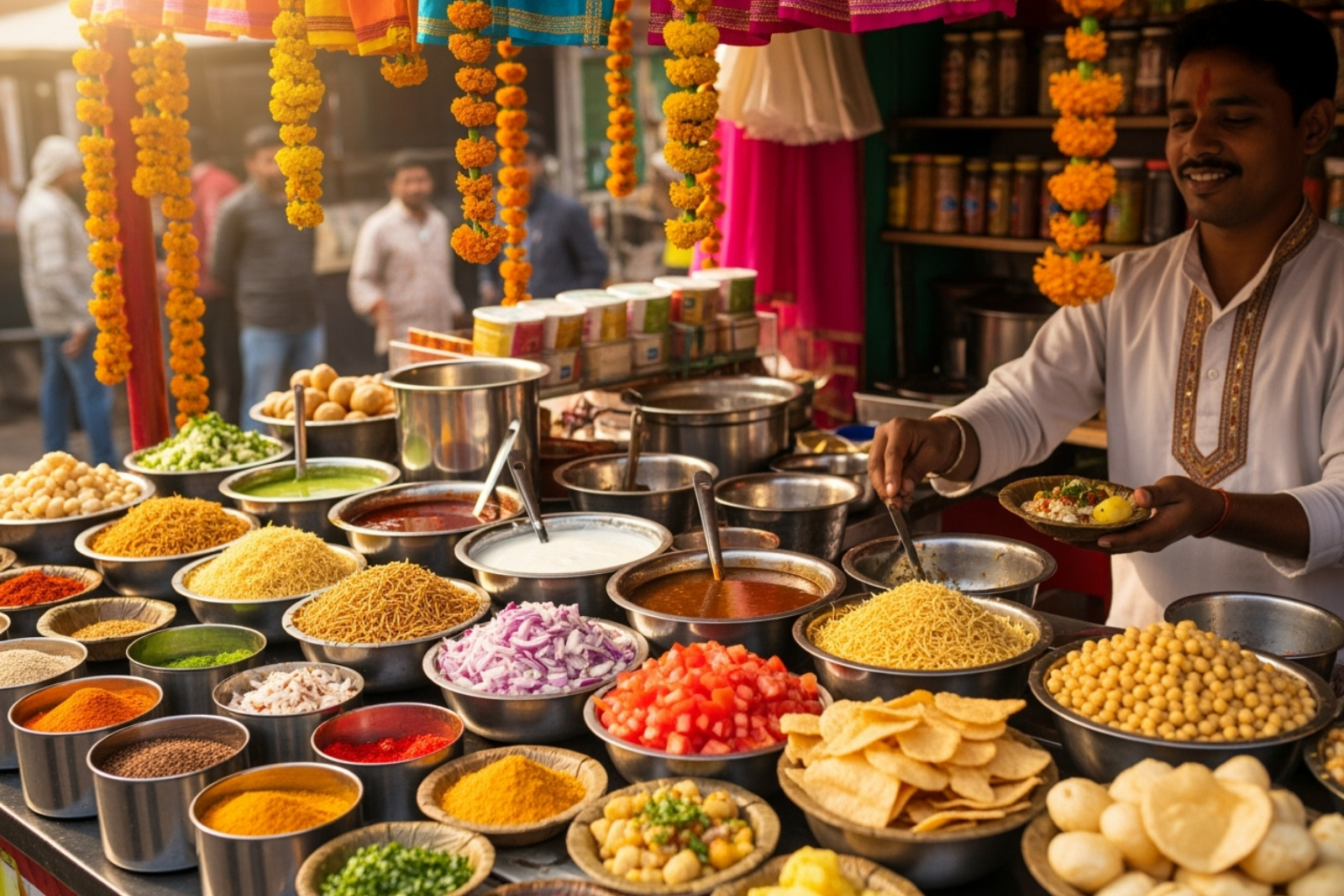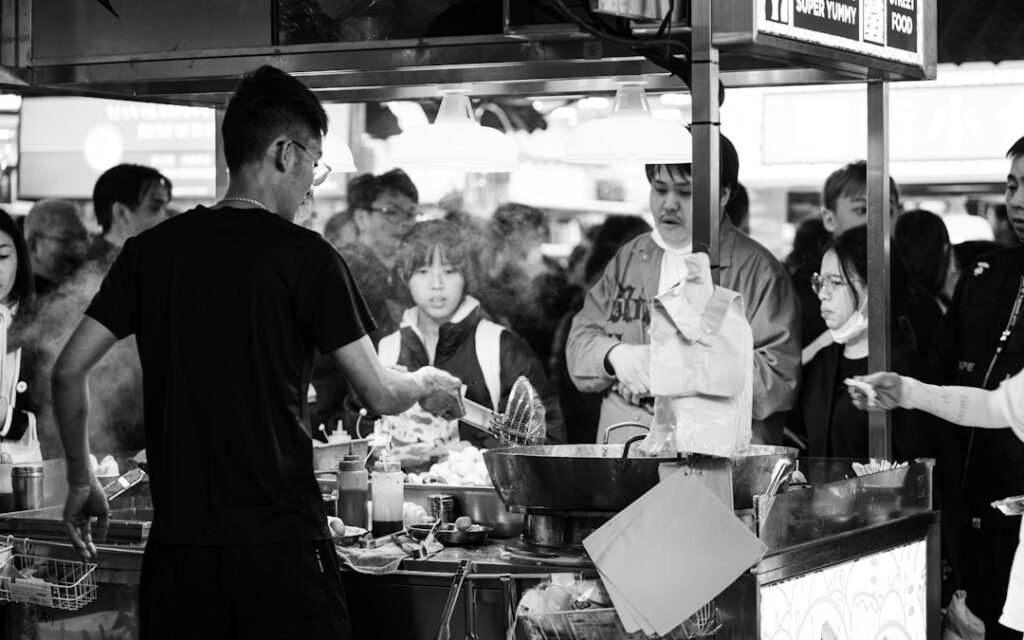More Than Just a Meal
Street food culture is more than just a quick bite; it’s a vibrant mirror reflecting a place’s history, economy, and community. It offers an authentic and affordable way to experience local life. With an estimated 2.5 billion people eating street food daily, it’s a global phenomenon that connects us through shared culinary experiences. From ancient markets to modern food trucks, street food tells the story of a place and its people.

Important Street food culture terms:
A Culinary Time Machine: The History of Street Food
The history of street food culture is as old as cities themselves. In ancient Greece, vendors sold fried fish and other simple meals to urban residents. This tradition continued through the centuries, with stalls and carts providing affordable food for the working class across different cultures. The Industrial Revolution saw the rise of iconic street foods catering to factory workers. Street food also tells a story of cultural exchange. For example, many dishes found in Bangalore reflect a long history of trade and influence, while Balinese street food is deeply connected to the island’s unique heritage. These dishes are living history, showing how food evolves with migration and cultural fusion. For a deeper dive, you can explore the history of street food in more detail.
The Heartbeat of the City: Economic and Social Impact of Street Food Culture
Street food culture is a powerful economic and social engine, driving local economies and bringing communities together.
The Economics of the Curb: Affordability and Local Employment
Street food offers an affordable way to enjoy high-quality meals, a key factor for the 30% of consumers affected by rising prices. This demand fuels a booming industry, with the U.S. street vendor market projected to hit $3.9 billion by 2024. It provides a low-barrier entry to entrepreneurship, creating jobs and supporting local economies, especially for women in developing nations. In cities like Bangalore, this sector is a vital economic force.
From Farm to Cart: The Role of Local Agriculture
Street food culture is a delicious reflection of a region’s agriculture. Mexican corn tortillas, Asian rice dishes, and coastal seafood specialties all showcase local ingredients. By sourcing locally, vendors support farmers and preserve traditional recipes that have been passed down for generations, offering a true taste of the local terroir.
Want to explore how local ingredients shape incredible cuisine? Join us on our Athens Street Food Tour!
The Great Unifier: Street Food and Community
Beyond economics, street food culture builds community. Street food stalls and markets are natural social hubs where people from all walks of life connect over a shared love of food. This communal dining experience breaks down social barriers and helps preserve cultural heritage, as recipes and traditions are passed from one generation to the next.
Curious to see how street food unites communities? Find more on our Street Food Tours!
A Tale of Two Kitchens: A Deep Dive into Bangalore and Balinese Street Food

The street food culture of Bangalore and Bali springs from rich, ancient traditions, yet each has blossomed into a distinct culinary identity. Below is a concise comparison that highlights what makes each destination’s curb-side cuisine so memorable.
| Feature | Bangalore (India) | Bali (Indonesia) |
|---|---|---|
| Spices & Flavors | Vibrant colours; a dynamic balance of tangy, sweet, and spicy notes. | Aromatic and complex; use of fresh spice pastes (basa gede). |
| Key Dishes | Dosa, Vada Pav, Chaat, Pani Puri, Idli, Bhel Puri. | Sate Lilit, Babi Guling, Nasi Jinggo, Lawar, Jaje Bali (sweets). |
| Cooking Methods | Griddling, deep-frying, steaming; quick snacks and flavourful curries. | Grilling, roasting, steaming in banana leaves; often communal preparations. |
| Vegetarian Focus | Extensive vegetarian repertoire due to large vegetarian population. | Vegetarian options exist, but menus often feature meat, especially pork. |
| Overall Style | Snack-oriented, regionally diverse and often lighter on the palate. | Savoury and ceremonial, deeply connected to local ingredients and community. |
Flavors of Bangalore: A Vibrant Mosaic
Bangalore’s street food culture showcases dazzling variety. From crispy dosas to tangy pani puri, each bite captures India’s passion for spice, texture, and aroma. Vegetarian favourites flourish thanks to the country’s sizeable plant-based population.
Explore India’s rich culinary traditions on our Bangalore Street Food Tour.
Tastes of Bali: Rich and Communal
Bali’s street food culture is synonymous with aromatic grills and food deeply connected to ceremony. Dishes such as sate lilit and nasi jinggo reveal a focus on fresh, local ingredients and communal-style eating, delivering complex, satisfying flavours.
Experience these unique tastes on our Bali Street Food Tour.
The Modern Palate: How Street Food is Evolving Today
Street food culture is constantly evolving, blending tradition with innovation.
The Rise of the Gourmet Cart: Innovation in Street Food Culture
Today’s street food culture is experiencing a remarkable change. Talented chefs are taking traditional street food concepts and elevating them with high-quality ingredients and sophisticated cooking techniques. This “gourmet street food” movement proves that delicious, accessible food doesn’t have to compromise on quality or creativity.
The innovation doesn’t stop at flavor combinations. Modern street food vendors are increasingly embracing healthier options and plant-based dishes that cater to today’s health-conscious consumers. Vegan food trucks are popping up everywhere, serving everything from jackfruit tacos to cashew-based ice cream. These vendors show how street food culture can evolve with the times while maintaining its core values of affordability and accessibility.
This focus on fusion cuisine and culinary innovation is creating what many call experiential dining – where grabbing a quick bite becomes a memorable culinary trip. Whether it’s Korean-Mexican fusion burritos or Mediterranean-inspired falafel wraps, today’s street food scene celebrates creativity and cultural exchange.
Experience innovative flavors on our Bali Street Food Tour.
New Venues for an Old Tradition: Food Trucks and Food Halls
Street food culture has found new homes in food trucks and food halls. Food trucks act as mobile culinary ambassadors, bringing diverse cuisines to new neighborhoods. Meanwhile, food halls gather various vendors under one roof, creating vibrant, curated marketplaces that preserve the community spirit of street food in a modern setting.
These modern venues successfully preserve the street food spirit while adapting to contemporary dining expectations. They maintain the communal atmosphere and diverse offerings that make street food special, just in a more organized package.
The Digital Bite: Convenience and Consumer Preferences
Technology has revolutionized how we experience street food culture. Digital ordering and delivery apps have expanded the reach of street food vendors far beyond their physical locations. Now you can enjoy authentic street tacos or Vietnamese bánh mì from the comfort of your home or office.
This digital change addresses our modern need for convenience while supporting small vendors who might not have the resources for traditional marketing. Apps help customers find new vendors and allow businesses to manage orders more efficiently, creating a win-win situation.
Consumer demand for convenience has also shaped what vendors offer. Quick-service formats, portable packaging, and ready-to-eat options have become essential. Yet this focus on speed doesn’t sacrifice the authentic flavors that make street food special.
The trend toward affordable indulgence continues to drive the market, with consumers seeking high-quality experiences that don’t break the bank. This has created opportunities for CPG and retail brands to develop products inspired by popular street food flavors, bringing these tastes to grocery store shelves.
Learn more about how technology is changing food experiences with our insights on Food Tourism Technology.
Navigating the Future: Challenges and Opportunities
The vibrant world of street food culture faces both challenges and exciting opportunities as it evolves.
The Vendor’s Dilemma: Regulations and Economic Viability
For many aspiring entrepreneurs, the dream of opening a food cart is met with bureaucratic problems. In many large cities, strict permit caps and high costs can be prohibitive. Gentrification also poses a threat, as rising rents can push out traditional vendors. Balancing authenticity with the need to appeal to a broader market is another ongoing challenge for these small business owners.
Health, Safety, and Trust in Street Food Culture
Food safety is a common concern, but many vendors maintain high standards. A good rule of thumb is to choose busy stalls with high turnover, as this indicates fresh food. Observe the vendor’s cleanliness and ensure food is cooked to order. Cities are also stepping up, with some providing a model for clean, regulated environments that don’t sacrifice authenticity.
For more tips on making smart choices, check out our guide on How to Find Authentic Local Eats in Any City.
The Enduring Appeal and Future Outlook
Despite challenges, the future of street food is bright. Its inherent adaptability allows it to accept new trends like plant-based diets and fusion cuisine. Media attention from shows like Netflix’s “Street Food” and the power of social media have liftd its status, turning local vendors into global stars. As a key driver of tourism, street food offers the authentic, affordable, and convenient experiences modern travelers crave.
Stay ahead of culinary trends with our insights into Culinary Travel Trends.
A Global Phenomenon: From Athens to Bali
The beauty of street food culture is its ability to be both universal and uniquely local. While the tradition of selling food on the street is global, its expression is deeply tied to place. In Athens, you can taste history in a simple souvlaki, a tradition with ancient roots. Travel to Bangalore, and you’ll find a busy, snack culture bursting with spice and variety, from dosas to chaat. In Bali, street food is often intertwined with community and ceremony, featuring aromatic grilled meats and delicate sweets wrapped in banana leaves. Exploring the street food culture in each of these destinations offers a direct and delicious connection to its people and heritage.
| Must-Try Dish | Where to Experience It |
|---|---|
| Souvlaki (Greek) | On our Athens Street Food Tour |
| Masala Dosa (Indian) | On our Bangalore Street Food Tour |
| Sate Lilit (Balinese) | On our Bali Street Food Tour |
Next time you travel, let your taste buds lead the way—another reminder that street food culture is truly global.
The Modern Palate: How Street Food is Evolving Today
Street food culture has never been more exciting than it is today. What started as simple necessity has blossomed into a culinary art form that accepts innovation while honoring tradition. From gourmet carts serving fusion tacos to digital apps delivering your favorite street eats, street food is adapting beautifully to our modern lives.
The Rise of the Gourmet Cart: Innovation in Street Food Culture
Today’s street food culture is experiencing a remarkable change. Talented chefs are elevating traditional street food with high-quality ingredients and sophisticated techniques. This “gourmet street food” movement proves that accessible food can still be creative and high-quality. Vendors are also embracing healthier options and plant-based dishes, from jackfruit tacos to cashew-based ice cream, showing how street food evolves with consumer tastes while maintaining its core values of affordability and accessibility. This focus on fusion cuisine and culinary innovation creates a memorable experiential dining trip.
Experience innovative flavors on our Bali Street Food Tour.
New Venues for an Old Tradition: Food Trucks and Food Halls
Street food culture has found exciting new homes that blend tradition with modern convenience. Food trucks have become mobile ambassadors of street food, bringing authentic flavors to office districts, festivals, and neighborhoods.
Food halls represent another evolution, bringing diverse vendors under one roof to create vibrant social spaces. Food halls are a prime example of this model, preserving the authentic spirit of street food in a clean, organized environment for both vendors and diners.
These modern venues successfully preserve the street food spirit while adapting to contemporary dining expectations, maintaining the communal atmosphere and diverse offerings that make street food special.
The Digital Bite: Convenience and Consumer Preferences
Technology has revolutionized how we experience street food culture. Digital ordering and delivery apps have expanded the reach of street food vendors far beyond their physical locations, allowing you to enjoy authentic street food from home. This digital shift addresses our modern need for convenience while supporting small vendors. The trend toward affordable indulgence continues to drive the market, with consumers seeking high-quality experiences that don’t break the bank.
Learn more about how technology is changing food experiences with our insights on Food Tourism Technology.
Navigating the Future: Challenges and Opportunities
The world of street food culture is thriving, but it’s not without its challenges. From bureaucratic red tape to changing urban landscapes, the future of street food depends on how well we address these issues while embracing new opportunities.
The Vendor’s Dilemma: Regulations and Economic Viability
For many aspiring entrepreneurs, the dream of opening a food cart is met with bureaucratic problems. In many large cities, strict permit caps and high costs can be prohibitive. Gentrification also poses a threat, as rising rents can push out traditional vendors. Balancing authenticity with the need to appeal to a broader market is another ongoing challenge for these small business owners.
Health, Safety, and Trust in Street Food Culture
Food safety is a common concern, but many vendors maintain high standards. A good rule of thumb is to choose busy stalls with high turnover, as this suggests fresh ingredients. Observe the vendor’s cleanliness and ensure food is cooked to order. Cities are also stepping up, with some providing a model for clean, regulated environments that don’t sacrifice authenticity.
For more tips on making smart choices, check out our guide on How to Find Authentic Local Eats in Any City.
The Enduring Appeal and Future Outlook
Despite challenges, the future of street food is bright. Its inherent adaptability allows it to accept new trends like plant-based diets and fusion cuisine. Media attention from shows like Netflix’s “Street Food” and the power of social media have liftd its status, turning local vendors into global stars. As a key driver of tourism, street food offers the authentic, affordable, and convenient experiences modern travelers crave.
Stay ahead of culinary trends with our insights into Culinary Travel Trends.
Frequently Asked Questions about Street Food Culture
What makes street food so important to a culture?
Street food culture is a living expression of a place’s history and daily life. It offers an affordable and authentic taste of local traditions, often using recipes passed down through generations. It’s a social experience that brings communities together.
Is street food safe to eat?
Yes, generally, but it’s wise to be a savvy customer. Look for popular stalls with high turnover, as this indicates fresh food. Observe the vendor’s cleanliness and ensure food is cooked to order. Many cities also have health regulations in place for street vendors.
How is technology changing street food?
Technology is making street food culture more accessible than ever. Delivery apps bring your favorite dishes to you, while social media helps you find new vendors and hidden gems. For vendors, tech helps with marketing and managing their business.
Conclusion: Your Culinary Trip Awaits
From ancient Rome to modern-day food trucks, street food culture is a vibrant expression of community, history, and innovation. It is an adaptable and resilient culinary force that brings people together over delicious, affordable food.
At The Dining Destination, we believe street food is the gateway to a city’s soul. It is where you find authentic flavors and create lasting memories. Every bite tells a story of local agriculture, heritage, and passion.
Your next great culinary find is waiting on a street corner. Whether you’re traveling abroad or exploring the vibrant streets of Athens, Bangalore, or Bali, let street food culture be your guide to authentic experiences and unforgettable flavors.
Explore our guides to the world’s best dining experiences and restaurants.








